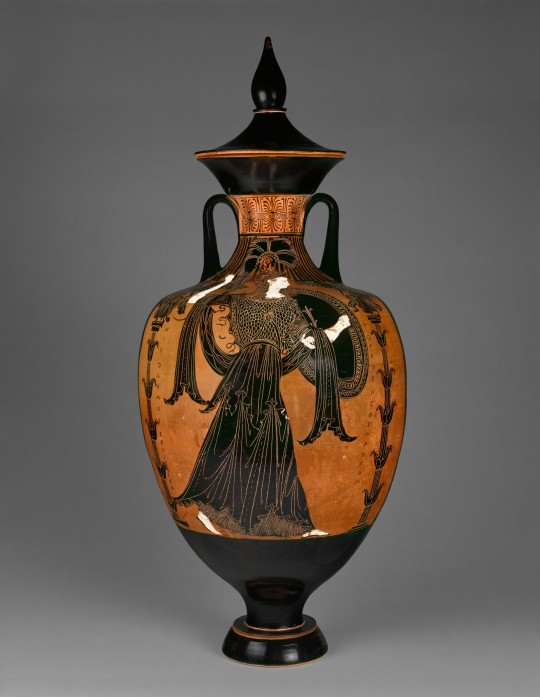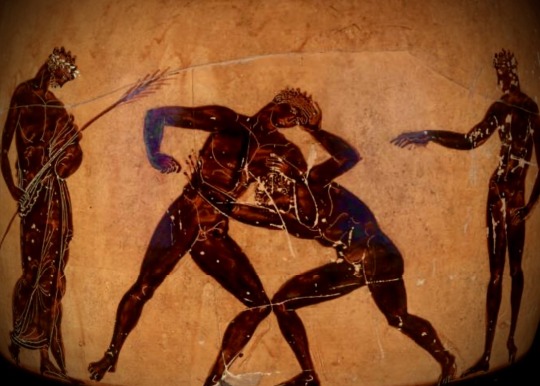#panathenaic
Explore tagged Tumblr posts
Text

Panathenaic Prize Amphora with Lid, 363–362 B.C.
35 1/4 in.
The Panathenaia, a state religious festival, honored Athena, the patron goddess of Athens. Held in its expanded form every four years, the festival included athletic, musical, and other competitions. Amphorae filled with oil pressed from olives from the sacred trees of Athena were given as prizes in the Panathenaic Games. These amphorae had a special form with narrow neck and foot and a standard fashion of decoration. One side showed Athena, the goddess of war, armed and striding forth between columns, and included the inscription "from the games at Athens." The other side showed the event for which the vase was a prize.
#ancient art#antiquities#greek antiquities#ancient greek#greek gods#greek mythology#olympics#olympic games#athena deity#amphora#athens#greece#ancient greece#ancient greek mythology#getty villa#getty museum#ancient gods#vase#ceramic vase#athena#4th century bc#games#prize#Panathenaic#ancient ceramics#black figure#olive oil
46 notes
·
View notes
Text

Panathenaic Stadium in Athens, Greece
Greek vintage postcard
#greece#photo#ansichtskarte#postal#postkaart#greek#sepia#tarjeta#ephemera#photography#carte postale#panathenaic stadium#historic#athens#briefkaart#postcard#vintage#panathenaic#postkarte#stadium
18 notes
·
View notes
Text

Panathenaic Prize Amphora: A Pot With Olive Oil Awarded at The Ancient Greek Olympics
Instead of a gold medal, victors at the ancient Greek Panathenaic Games received terra-cotta pots filled with Athenian olive oil from sacred trees.
Name: Panathenaic prize amphora.
What it is: A Greek terra-cotta pot known as an amphora.
Where it is from: Vulci, Italy.
When it was made: Circa 530 B.C., during Greece's Archaic period.
Unlike in today's Olympics — in which competitors receive gold, silver and bronze medals — each ancient winner received dozens of terra-cotta vases emblazoned with their specific sport and filled with Athenian olive oil, a highly "valuable prize," according to Harvard Art Museums.
The olive oil award given to Olympic champions came from the sacred groves of Athena, the patroness of Athens, according to the Metropolitan Museum of Art in New York City. In general, ancient Greeks considered olive trees "sacred," and they symbolized Zeus, the god of the sky and, later, the god of the Olympics, according to the Journal of Olympic History.
his particular amphora features a lineup of five runners during a footrace, a competition considered the "earliest known event in the Panathenaic Games," according to the Met. Athletes competed fully naked, since they thought their physiques might intimidate their competition, according to Southern Utah University.
The pot, which stands 24.5 inches (62 centimeters) tall, is attributed to "Euphiletos Painter." This anonymous artist was known for an art style called black-figure pottery, in which subjects were drawn in silhouette, according to the British Museum. This is just one of the many vases awarded to the victors at the Games, with other pots featuring charioteers, archers and boxers.
By Jennifer Nalewicki.
#Panathenaic Prize Amphora: A Pot With Olive Oil Awarded at The Ancient Greek Olympics#olympics#ancient greek olympics#amphora#terra-cotta#terra-cotta pot#athenian olive oil#sacred olive oil#ancient artifacts#archeology#archeolgst#history#history news#ancient history#ancient culture#ancient civilizations#ancient greece#greek history#greek art#ancient art
73 notes
·
View notes
Text

Full moon over the Panathenaic Stadium in Athens, #Greece
Credit: @d.tzankatian /
Instagram
https://www.instagram.com/d.tzankatian
90 notes
·
View notes
Text

Συμμετοχή του ΛτΕ στον εορτασμό στο Παναθηναϊκό Στάδιο, στις 7 Ιουλίου 1946, για την απόδοση των Δωδεκανήσων στην Ελλάδα. ΦΑΛΕ 12105
(Under the Article 14 of the Italian peace treaty negotiated in Paris between July 29-October 5, 1946, Italy officially transferred ownership of the Dodecanese to Greece. Great Britain annexed Cyprus in November 1914, after the Ottoman Empire had cast its lot with the Central Powers in the 1914-18 war.)
28 notes
·
View notes
Text
I thought about adding monographs and collections of essays that I read (almost) front to back for university to my Goodreads, so that I may feel better about my reading challenge progress because I have been reading a lot just not purely for leisure, but of course they are not in the Goodreads database yet and I don't feel like going through the effort of adding them myself. Guess I'll continue to look like an illiterate loser.
#jack's personal stuff#the book about the Panathenaic Price Amphoras was actually a surprisingly pleasant read#and maybe i can at least add athenaion polieteia once I am done with it#which i am reading really more out if curiosity... i already located the tiny bit i can quote for my eassy
4 notes
·
View notes
Text

I wake up screaming from dreaming / one day I'll watch as you're leaving / 'cause you got tired of my scheming / for the last time. // Taylor Swift, in Anti-Hero, from her album, Midnight (2022).
Image source: Panathenaic Prize Amphora with Lid (Getty Museum Collection).
#art piece#historical piece#getty museum#art collection#Panathenaic Prize Amphora with Lid#Painter of the Wedding Procession#nikodemos#greek (attic)#religious festival#athena#greek mythology#side a
0 notes
Text




I had an little vacation in Athens last week.
The Panathenaic Stadium. This is an ancient stadium that was refurbished and used for competitions in the Olympic games 1896 and 2004.
0 notes
Text
Awesome August
August is almost over but there are still the Paralympic Games that start today.
updated August 26, 2024 August is an exception among months. It has no major or federal holidays in the United States. Although the temperatures still feel hot and muggy, many students and teachers return to school and college for the “fall” semester. If you planned to buy a new swimsuit it’s too late. If you need a new winter coat, they’re available, if you want to try one on when it’s 95…
#Chicago#Democratic National Convention#Olympics#OU Health Sciences Center#Panathenaic Stadium#Paralympics#University of Oklahoma
0 notes
Text


Dune: Part Two, dir. by Denis Villeneuve // A Panathenaic amphora (Greece (Attica), ca. 365BC - 360BC) (x)
#paul atreides#feyd x paul#dune part two#comparatives#duneedit#dune comparatives#feyd rautha#paulfeyd#paul x feyd#feyd rautha harkonnen#dune#denis villeneuve#greig fraser#dune part 2#dune 2024#*#mine#*dune
10K notes
·
View notes
Text
Hills, History and Hidden Beauty - 2 Nights in Athens
I am back from 2 glorious weeks in Greece with the husband. Despite not being my first holiday, this is the first time I truly feel like I have had some proper downtime. We saw the sights, ate delicious food and spent some much-needed time together just relaxing. I still spent time writing and I found that having a clear headspace allowed for lots of inspiration, so over the next few weeks,…

View On WordPress
#Adventure#Ancient Greece#Aperol Spritz#Arch of Hadrian#Athens#Explore#Greece#History#Holiday#Liondi#National Gardens#Panathenaic Stadium#Parthenon#Temple of Olympian Zeus#The Acropolis#travel#Trip#Trip Advisor#Urban Frame Hotel#Vacation#Visit Athens#Xenios Zeus
0 notes
Photo

Terracotta Panathenaic prize amphora. ca. 530 BCE. Credit line: Rogers Fund, 1914 https://www.metmuseum.org/art/collection/search/248902
#aesthetic#art#abstract art#art museum#art history#The Metropolitan Museum of Art#museum#museum photography#museum aesthetic#dark academia
26 notes
·
View notes
Text

A GREEK GOLD OLIVE WREATH LATE CLASSICAL PERIOD TO EARLY HELLENISTIC PERIOD, CIRCA 4TH CENTURY B.C.
Unlike in the modern iteration of the festival, the ancient Olympics only had one winner per competition. Wild olive trees were native to Olympia, the site of the festival, and the arbiters of the games awarded their wreaths (called kotinoi in Greek) to the victor in each event. The association between the olive tree and physical prowess harkens back to a myth of young Herakles, who managed to kill the Cithareon lion using only his fists and a wooden stake from an olive tree. Gold wreaths such as the present example derive from these wearable trophies, but the fragility of the material makes it unlikely that those made from precious metal were meant to be worn in daily life. Rather, they were more likely dedicated in sanctuaries or placed in graves as funerary offerings. Indeed, the melted leaves at the front of this wreath may have been caused by the flames of a funeral pyre.
#A GREEK GOLD OLIVE WREATH#LATE CLASSICAL PERIOD TO EARLY HELLENISTIC PERIOD#CIRCA 4TH CENTURY B.C.#olympics#ancient Greek Panathenaic Games#Ancient Greek Olympics#gold#ancient artifacts#archaeology#archaeologists#history#history news#ancient history#ancient cultures#ancient civilizations#ancient greece#greek history#greek art#ancient art
70 notes
·
View notes
Text

Queen Pasiphae slept with a bull sent by Zeus, and gave birth to Minotaur, a creature half man – half bull. King Minos was embarrassed, but did not want to kill the Minotaur, so he hid the monster in the Labyrinth constructed by Daedalus at the Minoan Palace of Knossos.
According to the myth, Minos was imprisoning his enemies in the Labyrinth so that the Minotaur could eat them. The labyrinth was such a complicated construction that no one could ever find the way out alive.
Son of Minos, Androgeus, went to Athens to participate to the Panathenaic Games, but he was killed during the Marathon by the bull that impregnated his mother Pasiphae. Minos was infuriated, and demanded Aegeus the king of Athens to send seven men and women every year to the Minotaur to advert the plague caused by the death of Androgeus.
The third year, Theseus, son of Aegeus decided to be one of the seven young men that would go to Crete, in order to kill the Minotaur and end the human sacrifices to the monster. King Aegeus tried to make him change his mind but Theseus was determined to slay the Minotaur.
Theseus announced to King Minos that he was going to kill the Monster, but Minos knew that even if he did manage to kill the Minotaur, Theseus would never be able to exit the Labyrinth.
Theseus met Princess Ariadne, daughter of King Minos, who fell madly in love with him and decided to help Theseus. She gave him a thread and told him to unravel it as he would penetrate deeper and deeper into the Labyrinth, so that he knows the way out when he kills the monster.
Theseus followed her suggestion and entered the labyrinth with the thread. Theseus managed to kill the Minotaur and save the Athenians, and with Ariadne’s thread he managed to retrace his way out.
want to own a bunch of art like this? Then Please support my upcoming KICKSTARTER book in October! heres the LINK:
#pagan#hellenism#greek mythology#tagamemnon#mythology tag#percyjackson#dark academia#greek#greekmyths#classical literature#percy jackon and the olympians#pjo#homer#iliad#classics#mythologyart#art#artists on tumblr#odyssey#literature#ancientworld#ancienthistory#ancient civilizations#ancientgreece#olympians#greekgods#zeus#hesiod
188 notes
·
View notes
Text

Attributed to the Nichomachos Group (Greek (Attic)
Panathenaic Amphora with Lid, ca. 320 BC., terracotta, 112×42 cm
The J. Paul Getty Museum (Villa Collection, Malibu), Inv. 76.AE.5
74 notes
·
View notes
